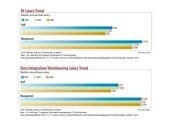Army Commanders: Let Us Choose Big Data AppsArmy Commanders: Let Us Choose Big Data Apps
The Army faces a technology control debate as some commanders ask to choose their own big data intelligence apps, looking to prevent more troop deaths from IEDs.


Big Data Talent War: 10 Analytics Job Trends
Big Data Talent War: 10 Analytics Job Trends (click image for larger view and for slideshow)
Many enterprise software vendors claim their products underpin customers' mission-critical applications or data. Few are able to point to reduced body counts.
In Afghanistan, better information and better analysis has helped reduce the number of deaths among Western coalition troops by 10% to 12% so far this year, according to the Pentagon.
During the first three months of 2012, only 5% of detected IEDs affected coalition troops, according to figures provided by the Pentagon's Joint IED Defeat Organization. Bombings and casualties rose during the warm, more-active months of the Afghan "fighting season," but are still 10% to 12% lower than this time last year, according to an AP story.
So far this year, IEDs have claimed only 44% of all coalition troops killed in Afghanistan, according to iCasualties.org, which tracks war-related deaths in Iraq and Afghanistan. During 2009, 61% of fatalities among U.S. troops in Afghanistan were due to IEDs. In 2010, the number dropped to 58%, according to iCasualties.
[ Read Army Plans Overhaul Of Virtual Training Games. ]
The steady drop is directly attributable to an increase in real-time information and observation of bomb planters from a growing network of observation towers, balloons, and observation aircraft, according to Lt. Gen. Michael Barbero, director of the Pentagon's Joint IED Defeat Organization.
During the early years of the war, coalition forces relied far more on tips from local Afghans, many of which were unreliable due to the questionable loyalties of those with good enough ties to the Taliban to have solid information on IEDs, and the questionable quality of intelligence from the rest, according to security analysts.
Towers, balloons, and aircraft allow U.S. and coalition troops to keep a direct eye on the roads being booby-trapped, while also making troops more effective in using remote-controlled robots and other standoff methods to check for or blow up IEDs before troops are in range. The higher the quality of information the military gets--especially real-time information gathered by direct observation--the more effectively it can operate and the less fighting troops have to do to accomplish their missions, John Arquilla, a professor of defense analysis at the Naval Postgraduate School, said Wednesday in an NPR story.
Army wants cloud, commanders prefer "bring-your-own" apps
For the Pentagon, the fly in the ointment is that some of its commanders in the field claim casualties are still higher than they should be because the Pentagon requires them to use intelligence and analyses from its custom-designed Distributed Common Ground System-Army (DCGS-A) tool--a massive, cloud-like series of interlinked systems that combines human and signal intelligence from all four military services to deliver recommendations, alerts, and warnings.
DCGS-A is a huge improvement over the nine standalone intelligence-analysis systems the army had used for intelligence of different types from different locations, according to PEO-IEWS, the Army unit responsible for developing new technologies to help combat troops in the field. The big difference between DCGS-A and other intelligence-distribution system is that previous efforts focused on feeding information to high-level commanders rather than those in the field.
DCGS-A was built with the realization that counter-insurgency tactics have to be set by and for commanders of ground troops in the field rather than generals in Washington. As a result, the system is designed to boil down intelligence from more than 200 sources of information to the point that local commanders can select, share, or correct the data according to their own immediate need to avoid IEDs or find insurgents.
The Army also is experimenting with an apps-store-like approach under which local commanders can choose among a series of other intelligence apps or analysis apps to suit their particular needs. All the apps are tied in to secure Pentagon intelligence systems and are approved for use in the field but are not a core part of a long-term Army software acquisition process.
The ability of commanders to choose their own software tools is almost unprecedented in the military, but isn't nearly enough flexibility, according to some field commanders. Some commanders in Afghanistan are pressing Army brass to approve their desire to use new analysis tools that are less cumbersome than the super-enterprise-sized DGCS-A and better at deriving useful answers from locally derived intelligence.
Fifth Stryker Brigade commander Col. Harry Tunnell IV, for example, blames the higher-than-expected casualties his unit suffered from IEDs during a deployment in 2009 at least partly on the denial of his request to use a big-data analytic app from Palantir Technologies, according to a story last month in the Washington Times.
Palantir's software is designed to focus on highly varied sets of data and pull from it otherwise innocuous connections between activities to identify potential terrorists. Its ability to correlate coincidences that aren't coincidental has gained it fans among the CIA and FBI, which use it to look for terrorists by correlating records of foreigners taking flying lessons using money received from overseas, for example, according to The Economist.
With Palantir, intelligence teams from local units could mine data from both local and Army sources to come up with concrete reports and recommendations on which local commanders could act, an ability Tunnell and other commanders complain is far weaker in the Army's preferred system. Using the data-sharing capability in Palantir, Tunnell told The Washington Times, the brigade caught a local Taliban commander heading to the brigade's area with a supply of IEDs after analysts were able to identify three separate reports as referring to different portions of the Taliban commander's route. The Army system would never have allowed local intelligence analysts to make that connection, Tunnell said.
Congress gets involved
Meanwhile, the debate continues between field commanders and top brass over how much flexibility local commanders should have in choosing the tools they feel they need to plan their operations, protect their troops, and accomplish their missions. Members of Congress including California Rep. Duncan Hunter (R-Calif) also have gotten involved, demanding an investigation into the process the Army uses to consider or deter technology requests as well as the long, hard road any commander faces to get an approval.
The Army Times reported, "In an August 23 letter obtained by Defense News, Hunter wrote that, 'From the time the Army's first conventional ground force requested the [Palantir] software in 2008, there have been deliberate efforts on the part of mid-level bureaucrats to deny units this resource despite repeated urgent requests from commanders.'"
Publicity from Tunnel's story, and pressure from Duncan and other members of Congress, succeeded in launching a Pentagon investigation into the issue of how quickly to evaluate applications requested by field commanders.
DCGS-A already has been slammed for poor reliability and "significant limitations" in a July memo from Gen. Genaro J. Dellarocco, head of the Army's test and evaluation command to Army Chief of Staff Gen. Ray Odierno, according to CNN. No concrete result or recommendation have followed, however.
When is bring-your-own too risky?
The Pentagon already is struggling with how to integrate commercial cell phones into its communications networks, as well as with more routine questions of when and how staffers can use their own technology, said Robert Carey, principal deputy CIO of the DoD, in National Defense, a publication of the National Defense Industrial Association.
Because nearly everything the modern military does is based more on information than firepower, even troops on the ground in Afghanistan need the same kind of connectivity and data access as those working in the U.S., Carey said.
The question Carey did not answer is that if something as comparatively simple as a cell phone creates "catalytic confusion" within the DoD, how much more danger could result from efforts to insert a bring-your-own-app policy?
information Government's GovCloud 2012 is a day-long event where IT professionals in federal, state, and local government will develop a deeper understanding of the options available today. IT leaders in government and other experts will share best practices and their advice on how to make the right choices. Join us for this insightful gathering of government IT executives to hear firsthand about the challenges and opportunities of cloud computing. It happens in Washington, D.C., on Oct. 17.
About the Author
You May Also Like






